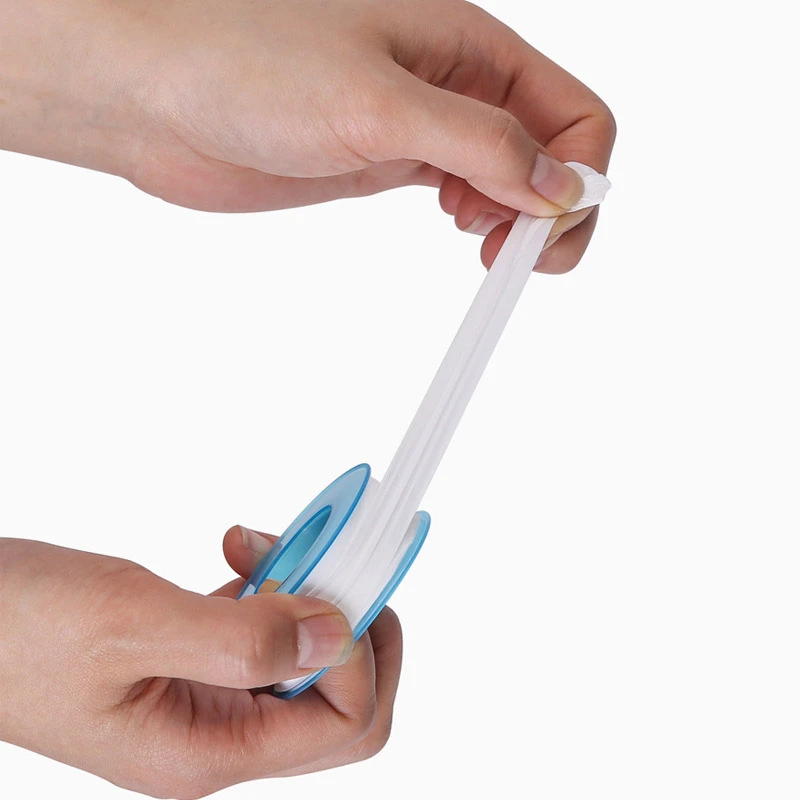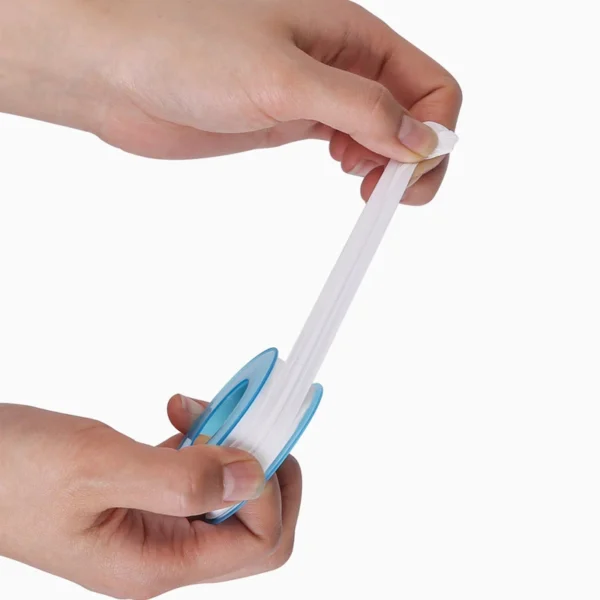You know that roll of thin white tape every plumber pulls out for threaded fittings? Yeah, the stuff that saves the day when water’s about to spray everywhere. If you’re knee-deep in a project and need to know if it’s up to snuff for your setup—maybe checking chemical makeup or how it holds under pressure—this breakdown’s for you. I’ve been slinging PTFE stuff for years at Teflon X, wrapping fittings on everything from home sinks to industrial rigs, and let me tell you, it’s more than just sticky ribbon. We’re talking a material that’s basically bulletproof against most corrosives. Stick around, and by the end, you’ll see why grabbing the right Industrial PTFE Plumbers Tape could make your next job a breeze.
Unpacking the PTFE Material: What’s Really in There?
Alright, let’s cut to the chase on what makes up this plumber’s best friend. At its core, plumbers tape is all about PTFE—polytetrafluoroethylene, if you wanna get fancy. But forget the jargon; think of it as a chain of carbon and fluorine atoms hooked together in a super-long line. The repeating bit? Just C2F4, over and over, like a molecular conga line that doesn’t break a sweat. No fillers, no weird additives in the pure stuff—it’s 100% that fluoropolymer goodness.
I remember the first time I tore open a fresh roll for a client’s gas line hookup. Smelled like nothing, which is kinda the point. Unlike those old-school pipe dopes that reek of chemicals and leave a mess, PTFE tape’s teflon tape composition is clean and simple. It’s extruded into that thin film you wrap around threads, usually about 0.003 inches thick for standard rolls. Why does that matter for you? If you’re auditing for compliance, this purity means it won’t leach junk into your water or air—key for food-grade or pharma setups.
Digging deeper, the way it’s made starts with tetrafluoroethylene gas getting polymerized under pressure. Boom, you get these long, straight chains that pack tight, hitting over 90% crystallinity. That structure’s what gives it the low friction slide—wrap it clockwise on male threads, and it compresses without gumming up. We’ve tested rolls from our Teflon X lineup side-by-side with generics, and the density holds at around 2.2 grams per cubic centimeter, so it doesn’t crush or flake under torque.
The Chemical Breakdown of Teflon Tape Composition
Want the nitty-gritty? Here’s a quick table on the atomic side—pulled straight from chem specs I’ve cross-checked on jobsites.
| Element/Compound | Percentage in PTFE | Why It Counts |
|---|---|---|
| Carbon (C) | ~24% | Forms the backbone chain, keeps it stable at wild temps. |
| Fluorine (F) | ~76% | The magic shield—repels water, oils, and acids like a pro. |
| Repeating Unit (C2F4) | 100% polymer | No impurities; inert to 95% of chemicals out there. |
No heavy metals, no halogens beyond the fluoro bonds. That teflon tape composition? It’s why it laughs off sulfuric acid or bleach—stuff that eats through rubber seals in minutes. One time, a buddy’s brewery line was corroding from hops residue; swapped to PTFE, and leaks vanished for months. If your spec sheet demands zero migration, this is your guy.
Key Properties of Plumbers Tape Material That Make It a Game-Changer
So, why bother with all this when duct tape’s right there? Because plumbers tape material isn’t just tough—it’s smart tough. Low coefficient of friction, clocking in at 0.05 to 0.10, means fittings spin on easy without galling. And heat? Handles -450°F to 500°F without warping, perfect for steam lines or cryogenic stuff.
From my toolbox tales, I’ve seen it seal 1/2-inch NPT threads at 300 psi no sweat. Electrical insulation’s another win—dielectric strength over 60 kV per millimeter, so no shorts in wet environments. Compare that to yellow gas tape, which might have additives for color but same base. White’s your all-purpose for water, and pink for plumbing codes in some spots.
Here’s a properties showdown table to visualize—based on real ASTM tests we’ve run at Teflon X.
| Milik | PTFE Value | Vs. Standard Rubber Seal |
|---|---|---|
| Kekuatan Tarik | 2,500-5,000 psi | 1,000-2,000 psi |
| Elongation at Break | 200-400% | 300-500% (but degrades faster) |
| Ketahanan Kimia | Excellent (pH 0-14) | Fair (attacks bases) |
| Service Temp Range | -200°C hingga 260°C | -40°C hingga 120°C |
See? It’s not even close. That stretch lets it conform to threads without tearing, and the temp range means no meltdowns in hot water heaters. For your eval, if you’re hitting FDA or NSF standards, PTFE’s non-toxic and non-absorbent—won’t harbor bacteria like some synthetics.
How PTFE Stacks Up Against Other Sealants
Ever tried pipe dope? Goopy, messy, and half the time it hardens wrong. Or those fiber gaskets that shred on install? PTFE tape’s the low-drama option. Take anaerobic sealants—they cure in the absence of air, great for high-vibe spots, but if you gotta take it apart later? Nightmare. Our industrial-grade stuff at Teflon X stays flexible, so disassembly’s a snap.
In one swap-out I did for a factory, they were using graphite yarn—worked okay but flaked into the process fluid, contaminating batches. Switched to Industrial PTFE Plumbers Tape, and zero particulates since. Density’s higher too, so thinner wraps do the job, saving material on big projects.
Real-World Wins: Stories from the Field
Look, specs are cool, but nothing beats hearing how it plays out. Take this unnamed Midwest plant—pumping corrosive brines through stainless lines. Leaks every quarter, downtime costing thousands. We rolled in with heavy-duty PTFE rolls, wrapped per the clockwise rule, and torqued to 25 ft-lbs. Six months later? Bone dry. They cut maintenance by 40%, and that was with off-the-shelf tape; imagine custom widths from Teflon X.
Or picture a coastal condo complex fighting saltwater intrusion. Threads on brass fittings were pitting fast. PTFE’s hydrophobicity—water contact angle over 110 degrees—kept moisture out, no rust-through. One engineer told me it was like wrapping the threads in invisible armor. We’ve got similar setups in breweries, where CO2 lines stay sealed under pressure swings, or pharma cleanrooms sealing valves without residue risks. These aren’t hypotheticals; I’ve got the torque wrenches and happy callbacks to prove it.
Safety First: Meeting Tech and Safety Norms with PTFE
Nobody wants a material that bites back. Good news: PTFE’s about as safe as it gets. OSHA flags decomposition products if you overheat it past 500°F—think fumes from burning—but at normal use? Zilch. No PEL needed since it’s inert, but we always vent workspaces anyway. EPA’s on board too; it’s TSCA-listed without red flags for environmental release.
For your compliance check, NSF/ANSI 61 certs it potable-water safe—no lead or heavy metals leaching. UL 94 V-0 for flame retardancy means it won’t fuel fires. I’ve audited installs against these, and PTFE sails through. If you’re in chem processing, its resistance to 260°C keeps reactions contained, dodging spills that could trigger hazmat protocols.
One caveat: don’t use on oxygen lines without special grades—static buildup risk—but for standard plumbing? Green light all day.
Why Choose Industrial PTFE Plumbers Tape from Teflon X?
At the end of the day, not all PTFE’s created equal. We’ve been knee-deep in this at Teflon X for over a decade, tweaking formulations for heavy-duty spots like yours. Our Industrial PTFE Plumbers Tape? It’s that 1 mil thick beast, 520 inches per roll, with density dialed for max seal without bulk. Clients rave about the conformability—hugs irregular threads like a glove.
Picture this: your project’s humming, no leaks derailing deadlines, costs staying low. That’s the PTFE edge. We’ve shipped to rigs from Texas oilfields to NYC high-rises, each time nailing the spec. Ready to spec it in? Hit up our halaman kontak or shoot an email to Allison.Ye@teflonx.com for a quote. Let’s chat details—maybe even a sample roll to test on your bench. What’s holding you back from leak-proof peace?
Tanya Jawab Umum
What’s the big difference between white and yellow plumbers tape?
White’s your go-to for water lines, pure PTFE without additives. Yellow’s got a bit more body for gas, but same base material. Both seal great, just match to code.
Can PTFE tape handle high-pressure steam systems?
Yep, up to 260°C and whatever psi your fittings rate for. We’ve sealed 150 psi boilers no problem—just wrap snug and torque right.
Is plumbers tape safe for drinking water pipes?
Totally, if it’s NSF-certified like ours. No leaching, no taste transfer—keeps your H2O pure as it flows.
Pita Pipa PTFE Industri | Pita Ulir Teflon Tugas Berat
Pita Pipa PTFE kelas industri kami dirancang untuk aplikasi yang paling sulit. Pita ulir Teflon tugas berat ini menawarkan ketahanan kimia dan suhu yang unggul, sehingga sangat cocok untuk sistem hidrolik dan pemrosesan kimia. Percayakan pita segel PTFE kami untuk menjaga integritas di lingkungan yang keras.



